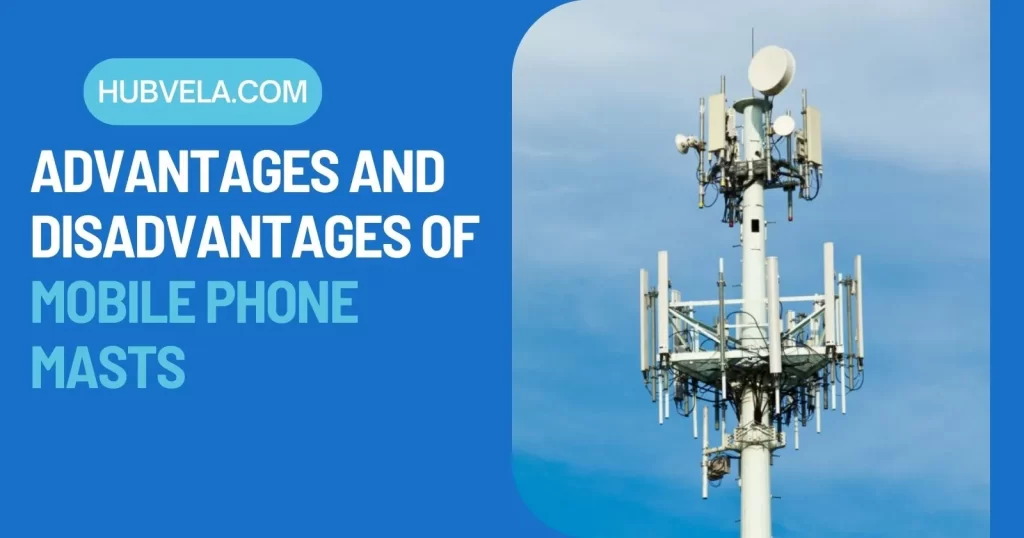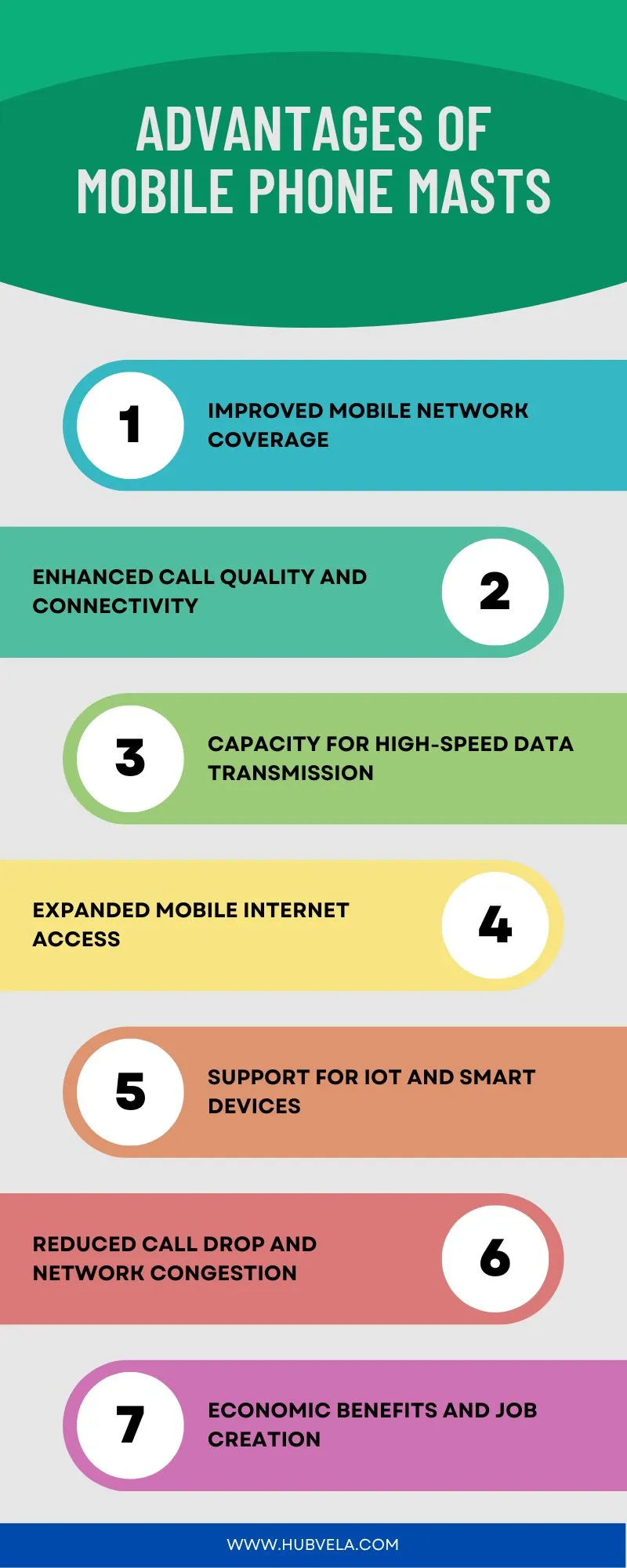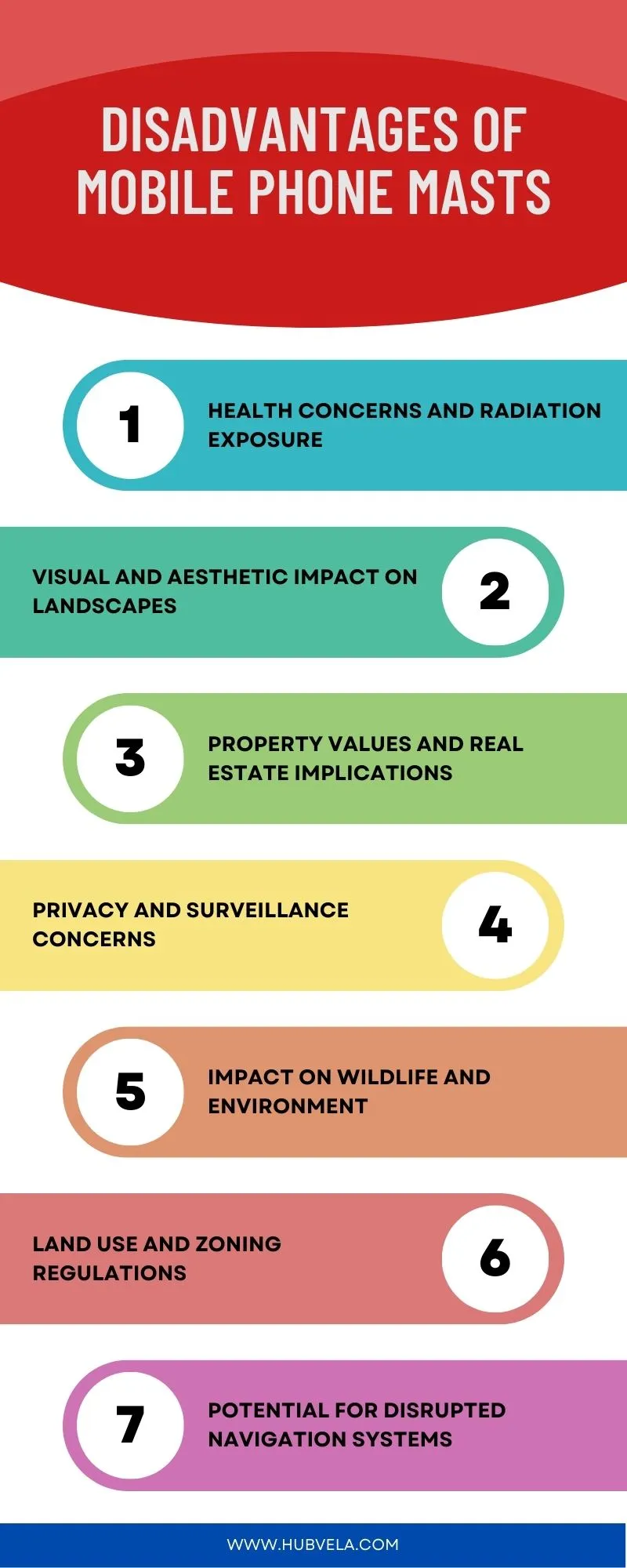Mobile phones have become an essential part of our daily lives, and with the increasing demand for better connectivity, mobile phone masts have become a common sight in many areas.
However, there are both advantages and disadvantages to having mobile phone masts in our communities.
In this article, we will explore the advantages and disadvantages of mobile phone masts, including their impact on connectivity, health, and aesthetics.

--Advertisement--
Advantages of Mobile Phone Masts
Mobile phone masts, also known as cell phone towers, are tall structures that are used to transmit and receive signals from mobile phones.
They are an essential part of the mobile phone network and have several advantages. We will discuss the advantages of mobile phone masts.

1. Improved Mobile Network Coverage
Improved mobile network coverage is one of the significant advantages of mobile phone masts. Mobile phone masts can be installed on street lights, bus shelters, and road signs to improve people’s mobile phone connection.
Mobile network providers can reduce the cost of mobile masts and improve mast regulation to provide better coverage.
Consumers and business customers can also take steps to check and improve their mobile phone reception, such as using Ofcom’s coverage checker.
The taller the mast, the wider the area it can cover, and the more people it can provide with a fast and reliable mobile signal.
Additionally, improving home Wi-Fi with a mesh system may be easier than trying to eke out a cellular signal where you live.
2. Enhanced Call Quality and Connectivity
Enhanced call quality and connectivity are some of the advantages of mobile phone masts. Tower updates directly contribute to improved call quality by enhancing the clarity, reliability, and stability of voice calls.
In addition, signal boosters for cell phones can improve reception and connectivity, resulting in better call quality. Satellite-based calls are also being explored as a future option for mobile phones, which could further enhance call quality and connectivity.
The use of AMR-WB, the first rendition of HD calling, also offers good call quality and much higher bitrates.
Understanding and optimizing cellular signals can also improve call quality and connectivity by addressing factors such as signal quality, the modem inside, data plans, network congestion, and local area networks.
Mobile phone masts provide enhanced call quality and connectivity, which is essential for reliable communication.
3. Capacity for High-Speed Data Transmission
One of the advantages of mobile phone masts is their capacity for high-speed data transmission. These masts are designed to transmit and receive large amounts of data at high speeds, which is essential for the functioning of modern mobile networks.
Phone masts are usually deployed on existing buildings and structures like blocks of flats, commercial property, water towers, or pylons.
The more phone masts there are in an area, the better the signal strength and the faster the data transmission. This is particularly important in rural areas where businesses need high-speed broadband to compete effectively.
Additionally, increasing the number of phone masts in an area means that they will emit with lower power to satisfy the same demand, which can result in less radiation exposure for mobile phone users.
4. Expanded Mobile Internet Access
Expanded mobile internet access refers to the increased availability of mobile network coverage in rural and remote areas.
Mobile phone masts play a crucial role in expanding mobile internet access as they enable mobile base stations to communicate with mobile phones via radio waves, allowing users to connect to the internet and make calls.
The benefits of mobile communication in rural communities are significant, as it creates equal learning and growth opportunities for individuals and businesses, promotes safety, streamlines operations, and fosters a stronger community.
Mobile connectivity also enables digital learning, enhances social connections, and increases efficiency for farmers and labor workers.
Mobile networks provide mobility, allowing users to access the internet from anywhere with a cellular signal without relying on a fixed location.
The advantages of mobile networks include productivity, accessibility, and portability. However, mobile networks have lower data transfer rates than DSL and fiber optics.
Fixed wireless internet and mobile wireless internet are two different types of internet sources.
Fixed wireless internet offers a point-to-point connection, which keeps latency low, while mobile wireless has a much higher latency because it prioritizes portability.
5. Support for IoT and Smart Devices
Mobile phone masts provide support for IoT and smart devices by enabling cellular connectivity.
Cellular IoT uses cellular networks to connect physical devices to the Internet, and the same cell towers that provide service to smartphones can connect heavy machinery, security systems, hospital equipment, asset tracking systems, and billions of other devices to the Internet.
IoT devices are nonstandard computing hardware that connects wirelessly to a network and can include sensors, actuators, or appliances.
Cellular connectivity enables these devices to transmit and receive data, so end-users can remotely monitor, analyze, and control them.
Cellular IoT is a cost-effective and affordable technology for many applications, including assets in motion and static assets, and it allows for remote management of connected devices regardless of location.
Therefore, mobile phone masts provide a crucial infrastructure for the growth and development of IoT and smart devices.
6. Reduced Call Drop and Network Congestion
Mobile phone masts have several advantages, including reduced call drop and network congestion.
The quality of the received signal determines the rate of dropped calls, and in cases where the network signal is low, mobile subscribers undergo high data costs, high consumption of battery power, and hard handovers.
Multiple devices connected to a single cell tower or router at the same time overload the network, leading to network congestion, which results in bandwidth degradation and decreased quality of services.
Mobile phone base stations must be carefully located in relation to each other, so each cell in the network functions efficiently to ensure minimum network congestion and good signal quality.
Inconsistent service can happen anywhere, and it can be caused by interference or obstruction, network congestion, and other factors like thick walls, base station contours, and underground areas like tunnels and subway stations.
7. Economic Benefits and Job Creation
Mobile phone masts have several economic benefits and can create job opportunities. The deployment of mobile phone masts requires labor-intensive work, which creates more jobs per unit of energy produced.
The widespread deployment of mobile phone masts can also assist in providing electricity to the 1.1 billion people who still lack access to it, especially in certain countries in sub-Saharan Africa where mobile phones are more prevalent in homes than electricity.
Additionally, the deployment of mobile phone masts can lead to the development of a “green economy” and create green jobs.
The Build Back Better Act in the United States aims to invest in workforce development programs to launch careers in growing industries such as clean energy, including the deployment of mobile phone masts.
The deployment of mobile phone masts can also potentially reduce carbon footprint and fully accommodate renewable and traditional energy sources.
Disadvantages of Mobile Phone Masts
Mobile phones have become an integral part of our daily lives, and with the increasing demand for better connectivity, the number of mobile phone masts has also increased.
However, the construction and use of these masts come with several disadvantages. We will explore the potential disadvantages of mobile phone masts, including:

1. Health Concerns and Radiation Exposure
Mobile phone masts have been a topic of concern regarding health risks associated with radiation exposure.
Cell phones emit radiofrequency radiation, which is a form of non-ionizing radiation, and some people are worried that this type of radiation could cause cancer or other health problems.
However, the weight of scientific evidence has not linked exposure to radiofrequency energy from cell phone use with any health problems at or below the radio frequency exposure limits set by the FCC.
The American Cancer Society states that it is not clear at this time that RF waves from cell phones cause harmful health effects in people, but studies now being done should give a clearer picture of the possible health risks.
2. Visual and Aesthetic Impact on Landscapes
Mobile phone masts have been criticized for their visual and aesthetic impact on landscapes. The proliferation of these masts has led to claims of visual pollution, which is a desire for a particular aesthetic in the environment.
The negative visual impact on the landscape is one of the perceived risks and drawbacks associated with mobile phone masts.
Geographers and landscape architects have examined the landscape aesthetics and other issues associated with changes in cultural landscapes.
The visual aesthetic quality of urban residential districts is affected by their own construction conditions and the surrounding districts and landscape areas.
The main disadvantage of assessing the visual attractiveness of a landscape is that it does not take into account the physiognomic diversity of complexes.
3. Property Values and Real Estate Implications
The construction of mobile phone masts can have implications for property values and real estate.
Some people may be hesitant to purchase or rent properties near mobile phone masts due to concerns about potential health risks associated with exposure to radiofrequency radiation.
This fear may lead to a decrease in demand for properties near mobile phone masts, which could result in a decrease in property values.
Additionally, some residents may be concerned that once a mobile phone mast is erected, it may be used to carry other hardware with potential health risks, which could further decrease property values.
However, it is important to note that research suggests that exposure to radiofrequency radiation from mobile phone masts does not pose a significant health risk.
4. Privacy and Surveillance Concerns
Mobile phone masts have been a subject of concern due to privacy and surveillance issues. The vulnerabilities in the mobile phone infrastructure can threaten personal privacy and security.
There have been increased conversations about the social dilemma of phone security and privacy, with speculation that devices and phones are listening to their users and tracking their interactions.
The use of mobile phone data has great potential for good, but its high dimensionality limits the applicability of traditional data anonymization methods, which can endanger the privacy of specific ethnic, religious, or minority groups.
Additionally, the presence of cell phone masts has been linked to significant deterioration of the health of the neighboring population.
While location tracking on mobile phones can be advantageous in emergency situations, it can also compromise privacy, as mobile phone carriers have been known to sell real-time customer location information to data brokers.
5. Impact on Wildlife and Environment
Mobile phone masts have been a topic of concern for their potential impact on wildlife and the environment. The electromagnetic radiation emitted by these masts can affect the behavior and health of birds, insects, and other animals.
Studies have shown that birds can experience disorientation and changes in their migratory patterns due to exposure to this radiation.
In addition, the construction of mobile phone masts can lead to deforestation and habitat destruction, which can have a negative impact on the local ecosystem.
The use of mobile phone masts also contributes to the overall increase in electronic waste, which can further harm the environment.
Therefore, it is important to consider the potential impact on wildlife and the environment when constructing and using mobile phone masts.
6. Land Use and Zoning Regulations
Land use and zoning regulations play a crucial role in determining the placement of mobile phone masts. However, the disadvantages associated with these masts have led to increased scrutiny of these regulations.
One of the main disadvantages of mobile phone masts is their potential impact on property values. Many people are concerned that the presence of a mobile phone mast near their home could decrease the value of their property.
Additionally, some studies have suggested that mobile phone masts could have negative health effects on nearby residents.
These concerns have led to increased pressure on local governments to tighten their land use and zoning regulations around mobile phone masts.
While these regulations can help mitigate some of the negative impacts of mobile phone masts, they can also limit the ability of mobile network operators to provide coverage in certain areas.
7. Potential for Disrupted Navigation Systems
Mobile phone masts have the potential to disrupt navigation systems, including those used in airplanes and hospitals.
According to a WHO fact sheet, mobile phones are often prohibited in hospitals and on airplanes due to the potential for radiofrequency signals to interfere with certain electro-medical devices and navigation systems.
GPS signals are also susceptible to both unintentional and intentional disruption. This vulnerability leaves critical infrastructure vulnerable to disruption, which could have serious consequences.
While no adverse health effects have been established as being caused by mobile phone use, the potential for disrupted navigation systems is a significant disadvantage of mobile phone masts.
Conclusion on Advantages and Disadvantages of Mobile Phone Masts
In conclusion, mobile phone masts have both advantages and disadvantages. On the one hand, they provide better network coverage and connectivity, which is essential in today’s society.
On the other hand, there are concerns about the potential health risks associated with exposure to radiation from these masts. While some studies have suggested a link between mobile phone radiation and cancer, the evidence is not conclusive.
Additionally, the use of mobile phones in schools and workplaces has its own set of advantages and disadvantages. While they can be useful tools for communication and productivity, they can also be a distraction and a source of disruption.
Ultimately, the decision to use mobile phones and mobile phone masts should be based on a careful consideration of the risks and benefits involved.


